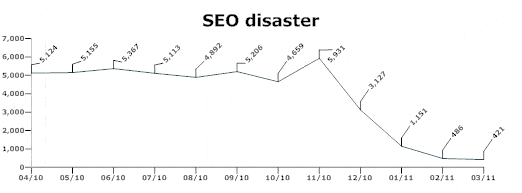I’ve been promoting software online for more than eleven years, so am entitled to reminisce a little.
I remember with fondness the good old days of Search Engine Optimisation. When I could optimise a client’s web page and see the results within a few days. When I would optimise different pages for different engines. When “invisible text” was as devious as it got. When using software to submit to thousands of websites was good for link popularity.
Today that’s changed. Today SEO has become more difficult and potentially more dangerous than in the good old days.
I recently came across a website that was ranking quite poorly in Google. The company admitted to having “tinkered with SEO” around the middle of last year.
Opening up a twelve month date range in their Analytics account confirmed that this was indeed the case:
The DIY SEO Catch-22 is simple.
To learn SEO you need to practice and develop your skills, yet doing so is dangerous.
Medical students don’t stitch wounds on their first day at University. They practice with bananas. The catch, however, is that bananas don’t cry out in pain, bleed or get infected. At some point the nervous medical student has to practice their skills on a live patient.
If SEO is to be handled by someone within your company, the first thing they learn shouldn’t be how to optimise a page or even how to choose keywords.
The first thing they learn should be the fundamentals. Assessment, hygiene and caution.
Too many businesses are complacent about the traffic they receive from Google, and are happy to experiment with little regard for the potential consequences.
If you’re happy to watch your Google traffic drop from 5,000 to 400, then by all means allow the intern with a copy of SEO for Dummies to optimise your website.
If you don’t want to experience the effect a Google drought can have on your business, make sure your SEO student learns the potential consequences of their actions before adjusting a single word.
Extensive damage can be caused in minutes. Recovery can take years.
Unique ideas for your business
The Demystifier puts practical ideas into your hands. You won't find them elsewhere. Original, actionable and insanely effective.



